Ecosystem Services’ Response to Land Use Intensity: A Case Study of the Hilly and Gully Region in China’s Loess Plateau
Abstract
1. Introduction
2. Overview of the Study Area and Data Sources
2.1. Overview of the Study Area
2.2. Data Sources
3. Methods
3.1. Research Framework
3.2. Grid Effect
3.3. Land Use Intensity
3.4. Ecosystem Service Assessment
3.4.1. Carbon Fixation Service
3.4.2. Water Production Service
3.4.3. Biodiversity Services
3.4.4. Soil Conservation Services
3.5. Ecosystem Service Volume Classification
3.6. Multi-Scenario Simulation of Land Use
3.6.1. PLUS Model and Accuracy Verification
3.6.2. Multi-Scenario Settings
- (1)
- Natural development scenario: By serving as the reference scenario for the others, this scenario operates under the assumption of no interference from local policies or planning frameworks. It forecasts land use demands in 2035 based solely on the land use transition probabilities observed in Zichang City between 2015 and 2020, as projected by the PLUS model [40].
- (2)
- Economic development scenario: This scenario posits a framework of unconstrained urban expansion. Derived from the land use transition matrix for 2010–2015, the following adjustments were made: a 60% increase in the transition probability from farmland to construction land, a 50% increase from grassland to construction land, and a 30% increase from unused land to construction land, while other transition probabilities remained unchanged [41].
- (3)
- Ecological protection scenario: In accordance with the directives outlined in the “Shaanxi Provincial Territorial Spatial Plan (2021–2035)” and the “Zichang City Territorial Spatial Plan (2021–2035)”, this scenario places paramount importance on ecological redlines and protective frameworks. Water systems and natural reserves within the study area collectively delineate restricted zones. Specific adjustments to land use transitions include the following: a 50% reduction in the probability of grassland and forest land converting to construction land; a 30% increase in the probability of farmland transitioning to forest land, and a 60% increase of it transitioning to grassland; a 50% decrease in the probability of farmland transitioning to construction land; an 80% reduction in the likelihood of forest land shifting to farmland, an 80% reduction in the likelihood of it shifting to grassland, and a 90% reduction in the likelihood of it shifting to construction land; a 20% increase in the probability of grassland transitioning to farmland and an 80% decrease in its probability of transitioning to construction land; a 20% increase in the probability of unused land transitioning to both farmland and forest land, and a 50% increase in the probability of it transitioning to grassland, with other transition probabilities remaining largely unchanged [42].
3.7. Bivariate Moran Index
4. Results
4.1. Spatial and Temporal Distribution of Land Use Intensity
4.2. Temporal and Spatial Changes of Ecosystem Services
4.3. Spatial and Temporal Distribution of Land Use Intensity in Multiple Scenarios
4.4. Spatial and Temporal Distribution of Multi-Scenario Ecosystem Services
4.5. Spatial Heterogeneity of Ecosystem Services in Relation to Land Use Intensity
5. Discussion
5.1. Mechanisms by Which Changes in Land Use Intensity Influence Ecosystem Services
5.2. Policy Implications
- (1)
- Zoning classification management and land use optimization. In ecologically sensitive areas and regions with high risks of soil erosion, it is essential to optimize land use structures by enhancing land planning and usage controls, as well as ensuring a rational allocation of forest and grassland proportions. Strict limitations should be imposed on the non-agricultural and non-grain conversion of arable land while promoting the intensive use of urban construction land to ensure the sustainability of land use [53].
- (2)
- Strengthening the enforcement of ecological protection red lines. Based on the “Three Red Lines” policy in territorial spatial planning, it is vital to establish the priority of ecological protection red lines in land management, ensuring the reasonable control of land use intensity. In ecologically vulnerable areas and key ecosystem service zones, measures such as stringent development controls and ecological restoration should be implemented to enhance regional ecological resilience [54].
- (3)
- Promoting ecological compensation mechanisms. It is important to reinforce ecological compensation mechanisms, incentivizing farmers and land users to participate in ecological protection through fiscal subsidies and ecological compensation measures, thereby ensuring the long-term benefits of ecological restoration [55].
- (4)
- Advancing sustainable agriculture and low-intensity development models. Encouraging the adoption of low-intensity land use practices, such as conservation tillage and precision agriculture, can help achieve a balance between agricultural production and ecological protection. Supporting the development of ecological agriculture and small-scale ecotourism can provide alternative economic benefits to local communities, reducing reliance on land resources [56].
- (5)
- Enhancing monitoring and early warning of land use intensity. Establishing a dynamic monitoring system that utilizes remote sensing and geographic information systems (GIS) to periodically assess the impacts of changes in land use intensity on ecosystem services is crucial. Early warning information should be issued for high-risk areas, providing timely evidence for policy adjustments.
- (6)
- Implementing territorial spatial planning tailored to local conditions. Considering the natural characteristics and socioeconomic conditions of the hilly and ravine region of the Loess Plateau, land use policies that align with local realities should be developed. This approach aims to maintain regional economic development while ensuring the sustainable provision of ecosystem services [54].
5.3. Limitations and Future Perspectives
6. Conclusions
Author Contributions
Funding
Data Availability Statement
Conflicts of Interest
References
- Jones, H.P.; Jones, P.C.; Barbier, E.B.; Blackburn, R.C.; Benayas, J.M.R.; Holl, K.D.; McCrackin, M.; Meli, P.; Montoya, D.; Mateos, D.M. Restoration and repair of Earth’s damaged ecosystems. Proc. R. Soc. B-Biol. Sci. 2018, 285, 20172577. [Google Scholar] [CrossRef] [PubMed]
- United Nations, Department of Economic and Social Affairs. Available online: https://www.un.org/zh/node/21032 (accessed on 1 August 2024).
- Zamboni, N.S.; Filho, E.M.N.; Carvalho, A.R. Unfolding differences in the distribution of coastal marine ecosystem services values among developed and developing countries. Ecol. Econ. 2021, 189, 107151. [Google Scholar] [CrossRef]
- Li, F.; Altermatt, F.; Yang, J.; An, S.; Li, A.; Zhang, X. Human activities’ fingerprint on multitrophic biodiversity and ecosystem functions across a major river catchment in China. Glob. Change Biol. 2020, 26, 6867–6879. [Google Scholar] [CrossRef] [PubMed]
- Wang, Q.; Bai, X. Spatiotemporal characteristics and driving mechanisms of land-use transitions and landscape patterns in response to ecological restoration projects: A case study of mountainous areas in Guizhou, Southwest China. Ecol. Inform. 2024, 82, 102748. [Google Scholar] [CrossRef]
- Hasan, S.S.; Zhen, L.; Miah, M.G.; Ahamed, T.; Samie, A. Impact of land use change on ecosystem services: A review. Environ. Dev. 2020, 34, 100527. [Google Scholar] [CrossRef]
- Stefanidis, S.; Proutsos, N.; Alexandridis, V.; Mallinis, G. Ecosystem Services Supply from Peri-Urban Watersheds in Greece: Soil Conservation and Water Retention. Land 2024, 13, 765. [Google Scholar] [CrossRef]
- Millennium Ecosystem Assessment. Ecosystems and Human Well-Being: Synthesis; Island Press: Washington, DC, USA, 2005. [Google Scholar]
- Foley, J.A.; DeFries, R.; Asner, G.P.; Barford, C.; Bonan, G.; Carpenter, S.R.; Chapin, F.S.; Coe, M.T.; Daily, G.C.; Gibbs, H.K.; et al. Global Consequences of Land Use. Science 2005, 309, 570–574. [Google Scholar] [CrossRef]
- Felipe-Lucia, M.R.; Soliveres, S.; Penone, C.; Fischer, M.; Ammer, C.; Boch, S.; Boeddinghaus, R.S.; Bonkowski, M.; Buscot, F.; Fiore-Donno, A.M.; et al. Land-use intensity alters networks between biodiversity, ecosystem functions, and services. Proc. Natl. Acad. Sci. USA 2020, 117, 28140–28149. [Google Scholar] [CrossRef]
- Chen, B.; Jing, X.; Liu, S.; Jiang, J.; Wang, Y. Intermediate human activities maximize dryland ecosystem services in the long-term land-use change: Evidence from the Sangong River watershed, northwest China. J. Environ. Manag. 2022, 319, 115708. [Google Scholar] [CrossRef]
- Kremen, C.; Miles, A. Ecosystem Services in Biologically Diversified versus Conventional Farming Systems: Benefits, Externalities, and Trade-Offs. Ecol. Soc. 2012, 17, 40. [Google Scholar] [CrossRef]
- Olaiya, A. Transforming Our World: The 2030 Agenda for Sustainable Development: International. Civ. Eng. = Siviele Ingenieurswese 2015, 24, 26–30. [Google Scholar]
- Degefu, M.A.; Argaw, M.; Feyisa, G.L.; Degefa, S. Dynamics of urban landscape nexus spatial dependence of ecosystem services in rapid agglomerate cities of Ethiopia. Sci. Total Environ. 2021, 798, 149192. [Google Scholar] [CrossRef] [PubMed]
- Le Noe, J.; Erb, K.-H.; Matej, S.; Magerl, A.; Bhan, M.; Gingrich, S. Socio-ecological drivers of long-term ecosystem carbon stock trend: An assessment with the LUCCA model of the French case. Anthropocene 2021, 33, 100275. [Google Scholar] [CrossRef]
- Dahan, K.S.; Kasei, R.A.; Husseini, R. Land use land cover (LULC) degradation intensity analysis of Guinea savannah and mosaic Forest savannah zones in Ghana. All Earth 2023, 35, 302–328. [Google Scholar] [CrossRef]
- Wang, Z.; Guo, M.; Zhang, D.; Chen, R.; Xi, C.; Yang, H. Coupling the Calibrated GlobalLand30 Data and Modified PLUS Model for Multi-Scenario Land Use Simulation and Landscape Ecological Risk Assessment. Remote Sens. 2023, 15, 5186. [Google Scholar] [CrossRef]
- Moindjie, I.-A.; Pinsard, C.; Accatino, F.; Chakir, R. Interactions between ecosystem services and land use in France: A spatial statistical analysis. Front. Environ. Sci. 2022, 10, 954655. [Google Scholar] [CrossRef]
- Shi, L.; Halik, U.; Mamat, Z.; Aishan, T.; Abliz, A.; Welp, M. Spatiotemporal investigation of the interactive coercing relationship between urbanization and ecosystem services in arid northwestern China. Land Degrad. Dev. 2021, 32, 4105–4120. [Google Scholar] [CrossRef]
- Ministry of Ecology and Environment of the People’s Republic of China. Available online: https://www.mee.gov.cn/xxgk2018/xxgk/xxgk15/202101/t20210115_817536_wh.html (accessed on 20 August 2024).
- Jorge-Garcia, D.; Estruch-Guitart, V.; Aragones-Beltran, P. How geographical factors and decision-makers’ perceptions influence the prioritization of ecosystem services: Analysis in the Spanish rice field areas in RAMSAR Mediterranean wetlands. Sci. Total Environ. 2023, 869, 161823. [Google Scholar] [CrossRef]
- Zhang, Z.; Liu, Y.; Sheng, S.; Liu, X.; Xue, Q. Evolving Urban Expansion Patterns and Multi-Scenario Simulation Analysis from a Composite Perspective of “Social–Economic–Ecological”: A Case Study of the Hilly and Gully Regions of Northern Loess Plateau in Shaanxi Province. Sustainability 2024, 16, 2753. [Google Scholar] [CrossRef]
- Zichang Municipal People’s Government. Available online: http://www.zichang.gov.cn/ (accessed on 20 August 2024).
- Resource and Environmental Science Data Platform. Available online: http://www.resdc.cn (accessed on 20 August 2024).
- Geospatial Data Cloud. Available online: https://www.gscloud.cn/sources/index?pid=1&rootid=1 (accessed on 20 August 2024).
- A Big Earth Data Platform for Three Poles. Available online: https://poles.tpdc.ac.cn/zh-hans/data/611f7d50-b419-4d14-b4dd-4a944b141175/ (accessed on 20 August 2024).
- Schmidt, H.; Rast, S.; Bao, J.; Cassim, A.; Fang, S.-W.; la Cuesta, D.J.-d.; Keil, P.; Kluft, L.; Kroll, C.; Lang, T.; et al. Effects of vertical grid spacing on the climate simulated in the ICON-Sapphire global storm-resolving model. Geosci. Model Dev. 2024, 17, 1563–1584. [Google Scholar] [CrossRef]
- Fahad, S.; Li, W.; Lashari, A.H.; Islam, A.; Khattak, L.H.; Rasool, U. Evaluation of land use and land cover Spatio-temporal change during rapid Urban sprawl from Lahore, Pakistan. Urban Clim. 2021, 39, 100931. [Google Scholar] [CrossRef]
- Feng, X.; Li, Y.; Wang, X.; Yang, J.; Yu, E.; Wang, S.; Wu, N.; Xiao, F. Impacts of land use transitions on ecosystem services: A research framework coupled with structure, function, and dynamics. Sci. Total Environ. 2023, 901, 166366. [Google Scholar] [CrossRef] [PubMed]
- Zhang, Y.; Zhao, X.; Gong, J.; Luo, F.; Pan, Y. Effectiveness and driving mechanism of ecological restoration efforts in China from 2009 to 2019. Sci. Total Environ. 2024, 901, 166366. [Google Scholar] [CrossRef]
- Martini, F.; Conroy, K.; King, E.; Farrell, C.A.; Kelly-Quinn, M.; Obst, C.; Buckley, Y.M.; Stout, J.C. A capacity index to connect ecosystem condition to ecosystem services accounts. Ecol. Indic. 2024, 167, 112731. [Google Scholar] [CrossRef]
- Jiang, C.; Zhang, H.; Zhang, Z. Spatially explicit assessment of ecosystem services in China’s Loess Plateau: Patterns, interactions, drivers, and implications. Glob. Planet. Change 2018, 161, 41–52. [Google Scholar] [CrossRef]
- Zhao, T.; Pan, J. Ecosystem service trade-offs and spatial non-stationary responses to influencing factors in the Loess hilly-gully region: Lanzhou City, China. Sci. Total Environ. 2022, 846, 157422. [Google Scholar] [CrossRef]
- Kohestani, N.; Rastgar, S.; Heydari, G.; Jouibary, S.S.; Amirnejad, H. Spatiotemporal modeling of the value of carbon sequestration under changing land use/land cover using InVEST model: A case study of Nour-rud Watershed, Northern Iran. Environ. Dev. Sustain. 2024, 26, 14477–14505. [Google Scholar] [CrossRef]
- Liu, X.; Liu, Y.S.; Wang, Y.; Liu, Z.J. Evaluating potential impacts of land use changes on water supply-demand under multiple development scenarios in dryland region. J. Hydrol. 2022, 610, 127811. [Google Scholar] [CrossRef]
- Aznarez, C.; Svenning, J.-C.; Taveira, G.; Baro, F.; Pascual, U. Wildness and habitat quality drive spatial patterns of urban biodiversity. Landsc. Urban Plan. 2022, 228, 104570. [Google Scholar] [CrossRef]
- Tamire, C.; Elias, E.; Argaw, M. Spatiotemporal dynamics of soil loss and sediment export in Upper Bilate River Catchment (UBRC), Central Rift Valley of Ethiopia. Heliyon 2022, 8, e11220. [Google Scholar] [CrossRef]
- Nasr, M.; Orwin, J.F. A geospatial approach to identifying and mapping areas of relative environmental pressure on ecosystem integrity. J. Environ. Manag. 2024, 370, 122445. [Google Scholar] [CrossRef] [PubMed]
- Mutale, B.; Qiang, F. Modeling future land use and land cover under different scenarios using patch-generating land use simulation model. A case study of Ndola district. Front. Environ. Sci. 2024, 12, 1362666. [Google Scholar] [CrossRef]
- Bacau, S.; Domingo, D.; Palka, G.; Pellissier, L.; Kienast, F. Integrating strategic planning intentions into land-change simulations: Designing and assessing scenarios for Bucharest. Sustain. Cities Soc. 2022, 76, 103446. [Google Scholar] [CrossRef]
- Peng, K.; Jiang, W.; Ling, Z.; Hou, P.; Deng, Y. Evaluating the potential impacts of land use changes on ecosystem service value under multiple scenarios in support of SDG reporting: A case study of the Wuhan urban agglomeration. J. Clean. Prod. 2021, 307, 127321. [Google Scholar] [CrossRef]
- Tang, H.; Halike, A.; Yao, K.; Wei, Q.; Yao, L.; Tuheti, B.; Luo, J.; Duan, Y. Ecosystem service valuation and multi-scenario simulation in the Ebinur Lake Basin using a coupled GMOP-PLUS model. Sci. Rep. 2024, 14, 5071. [Google Scholar] [CrossRef]
- Ahmadi-Mirghaed, F.; Rahmani, M.; Molla-Aghajanzadeh, S. Quantification of water yield concerning land use and climate scenarios in the Tajan watershed, North of Iran. Int. J. Environ. Sci. Technol. 2024. [Google Scholar] [CrossRef]
- Borrelli, P.; Robinson, D.A.; Fleischer, L.R.; Lugato, E.; Ballabio, C.; Alewell, C.; Meusburger, K.; Modugno, S.; Schütt, B.; Ferro, V. An assessment of the global impact of 21st century land use change on soil erosion. Nat. Commun. 2017, 8, 2013. [Google Scholar] [CrossRef]
- Chen, W.; Zeng, J.; Li, N. Change in land-use structure due to urbanisation in China. J. Clean. Prod. 2021, 321, 128986. [Google Scholar] [CrossRef]
- Oliver, T.H.; Isaac, N.J.B.; August, T.A.; Woodcock, B.A.; Roy, D.B.; Bullock, J.M. Declining resilience of ecosystem functions under biodiversity loss. Nat. Commun. 2015, 6, 10122. [Google Scholar] [CrossRef]
- Bai, Y.; Liu, Y.; Li, Y.; Wang, Y.; Yuan, X. Land consolidation and eco-environmental sustainability in Loess Plateau: A study of Baota district, Shaanxi province, China. J. Geogr. Sci. 2022, 32, 1724–1744. [Google Scholar] [CrossRef]
- Schirpke, U.; Tscholl, S.; Tasser, E. Spatio-temporal changes in ecosystem service values: Effects of land-use changes from past to future (1860–2100). J. Environ. Manag. 2020, 272, 111068. [Google Scholar] [CrossRef] [PubMed]
- Bennett, E.M.; Peterson, G.D.; Gordon, L.J. Understanding relationships among multiple ecosystem services. Ecol. Lett. 2009, 12, 1394–1404. [Google Scholar] [CrossRef] [PubMed]
- Xu, Y.; Tang, H.; Wang, B.; Chen, J. Effects of land-use intensity on ecosystem services and human well-being: A case study in Huailai County, China. Environ. Earth Sci. 2016, 75, 416. [Google Scholar] [CrossRef]
- Zheng, H.; Peng, J.; Qiu, S.; Xu, Z.; Zhou, F.; Xia, P.; Adalibieke, W. Distinguishing the impacts of land use change in intensity and type on ecosystem services trade-offs. J. Environ. Manag. 2022, 316, 115206. [Google Scholar] [CrossRef] [PubMed]
- Liu, Y.; Huang, X.; Liu, Y. Detection of long-term land use and ecosystem services dynamics in the Loess Hilly-Gully region based on artificial intelligence and multiple models. J. Clean. Prod. 2024, 447, 141560. [Google Scholar] [CrossRef]
- Rahman, M.M.; Szabo, G. Multi-objective urban land use optimization using spatial data: A systematic review. Sustain. Cities Soc. 2021, 74, 103214. [Google Scholar] [CrossRef]
- Liu, Y.; Zhou, Y. Territory spatial planning and national governance system in China. Land Use Policy 2021, 102, 105288. [Google Scholar] [CrossRef]
- Li, Y.; Zhang, X.; Cao, Z.; Liu, Z.; Lu, Z.; Liu, Y. Towards the progress of ecological restoration and economic development in China’s Loess Plateau and strategy for more sustainable development. Sci. Total Environ. 2021, 756, 143676. [Google Scholar]
- Qu, L.; Liu, Y.; Li, Y.; Wang, J.; Yang, F.; Wang, Y. Sustainable use of gully agricultural land and water resources for sustainable development goals: A case study in the Loess Plat. Land Degrad. Dev. 2023, 34, 4935–4949. [Google Scholar] [CrossRef]

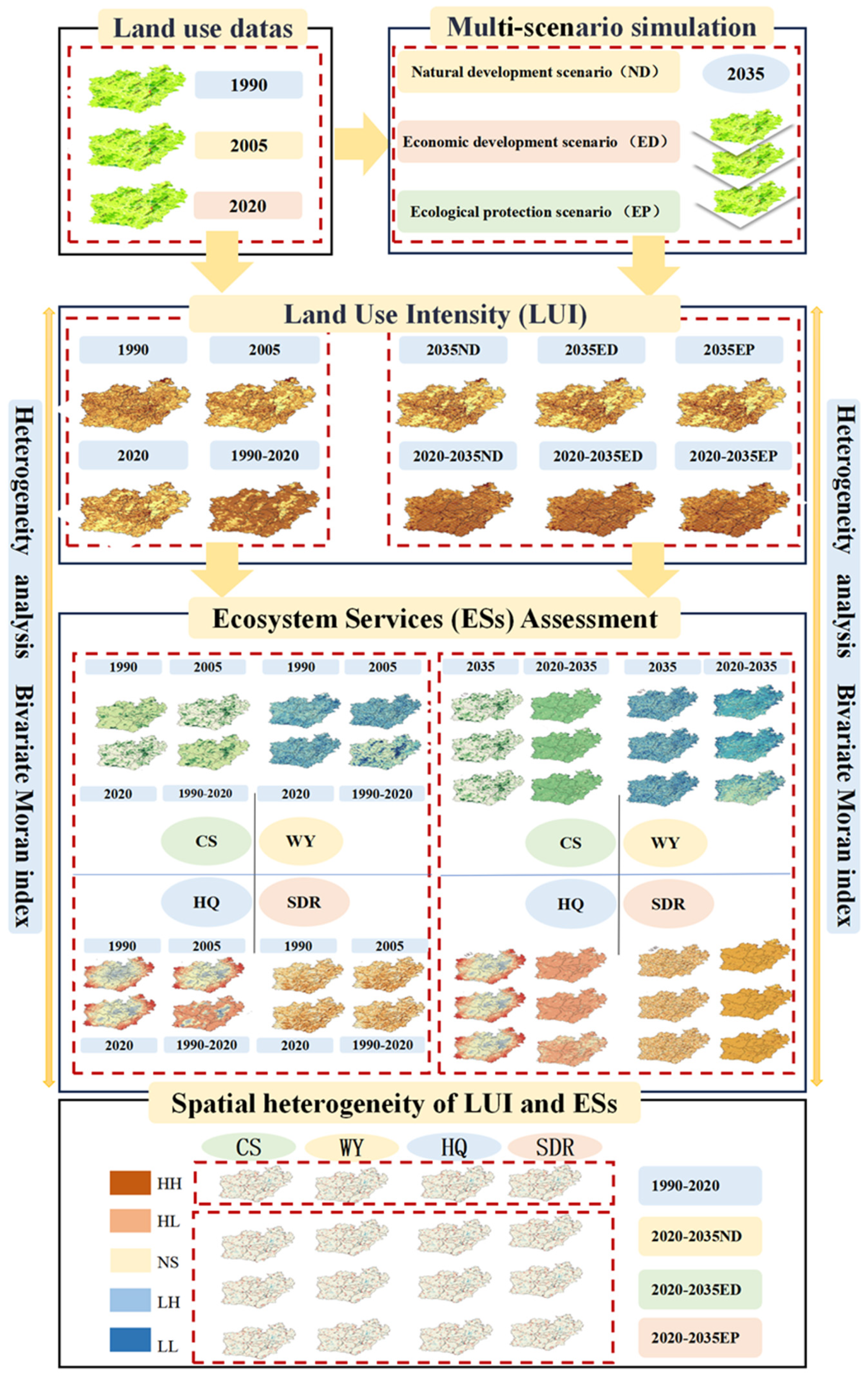
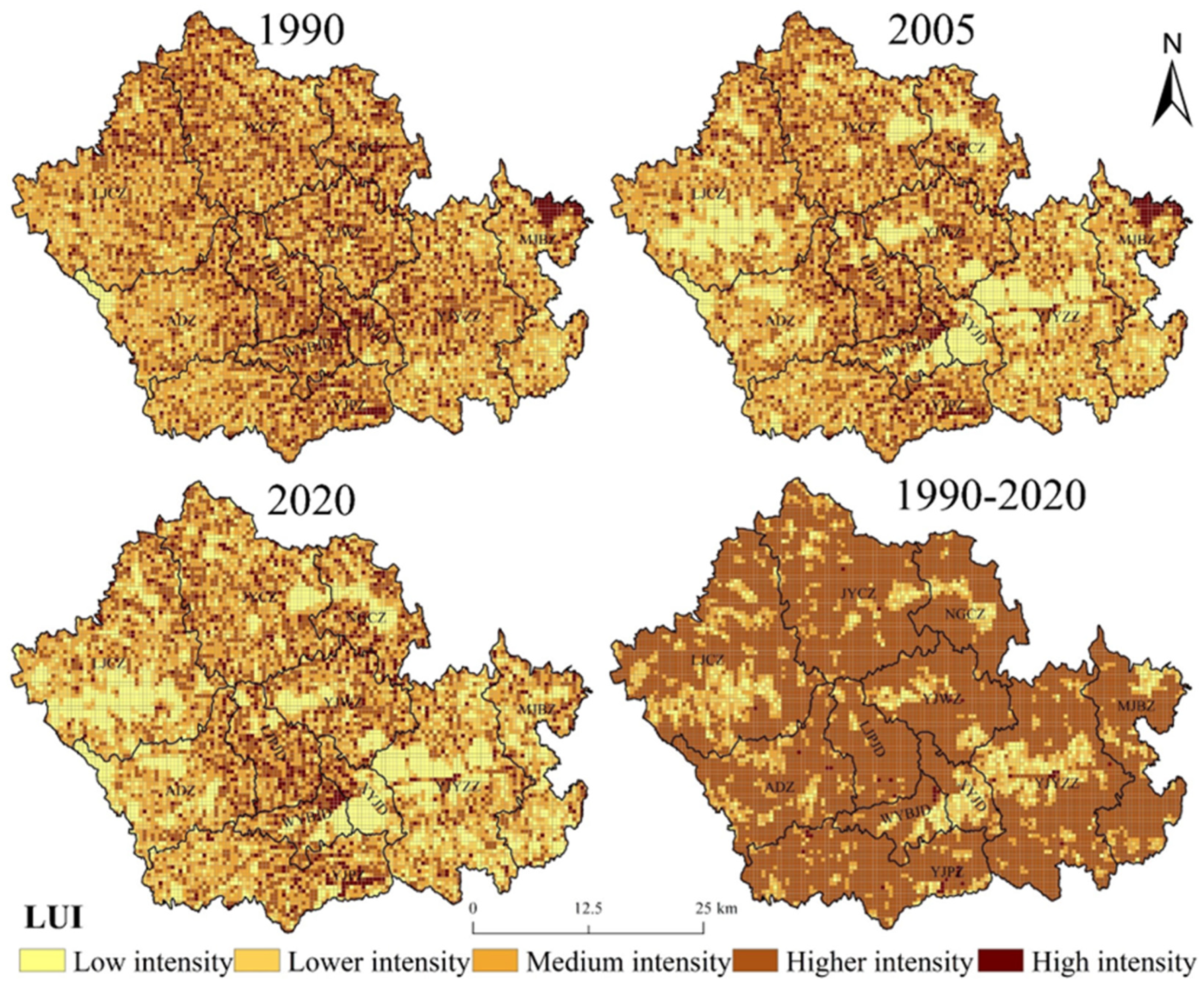
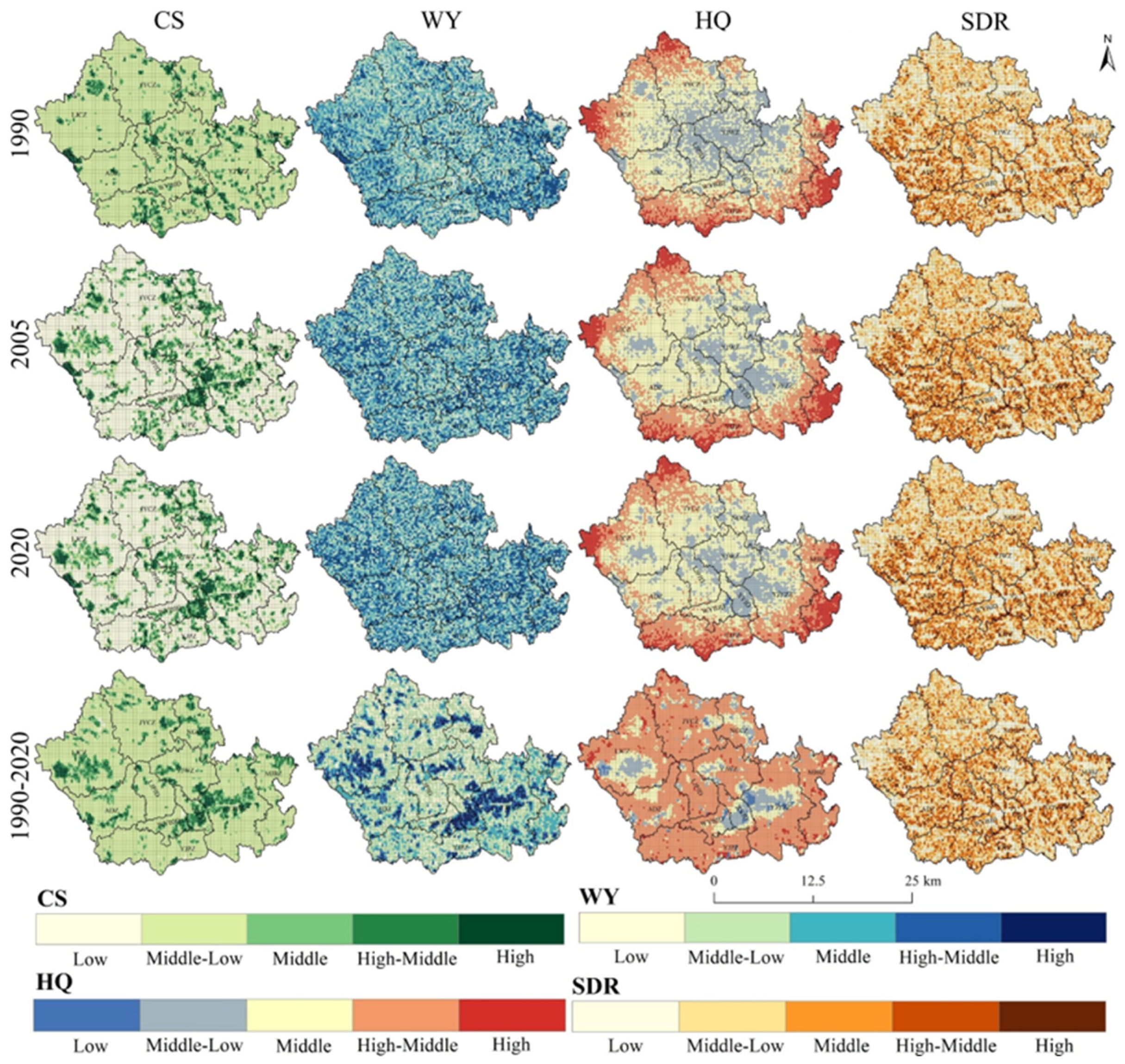
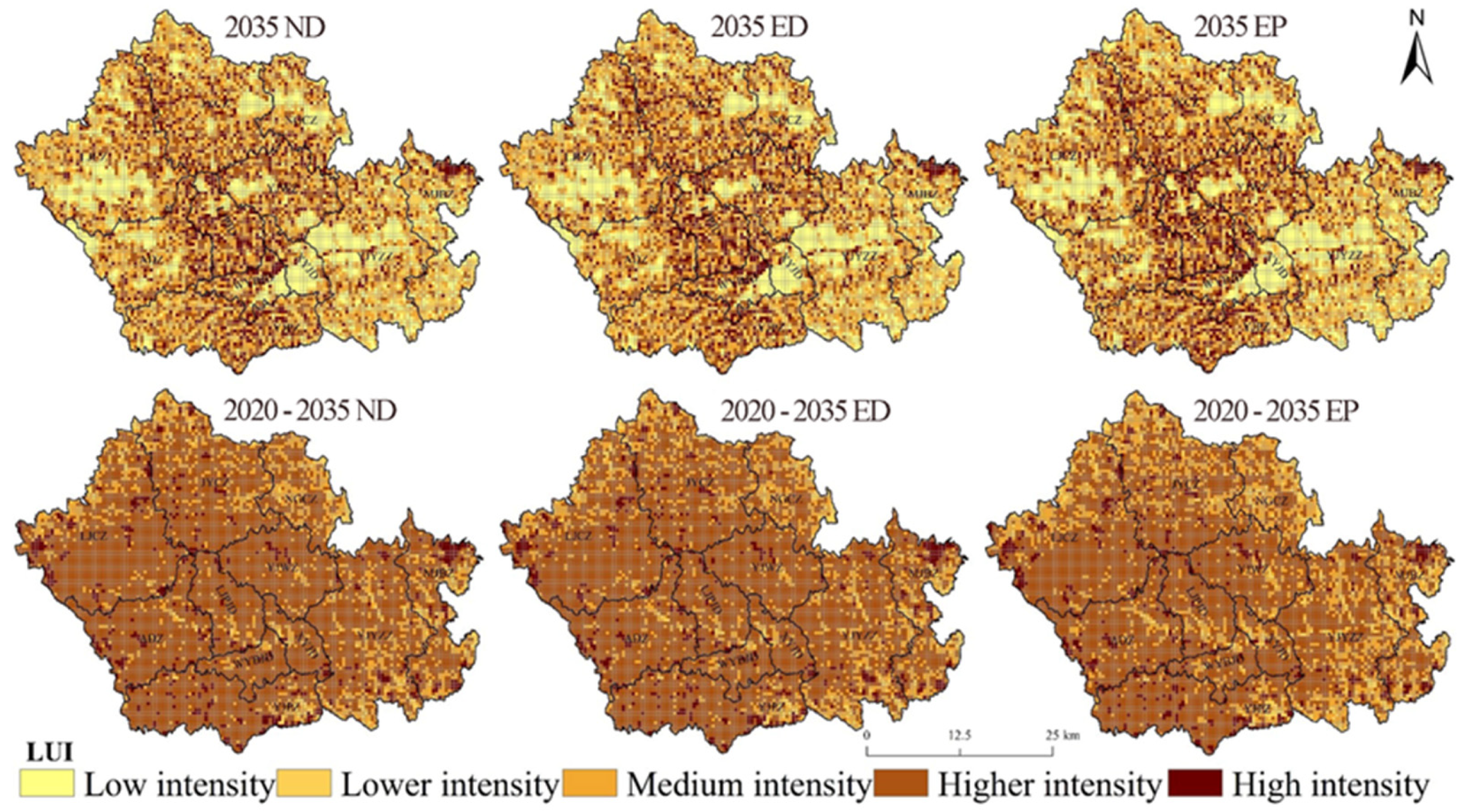

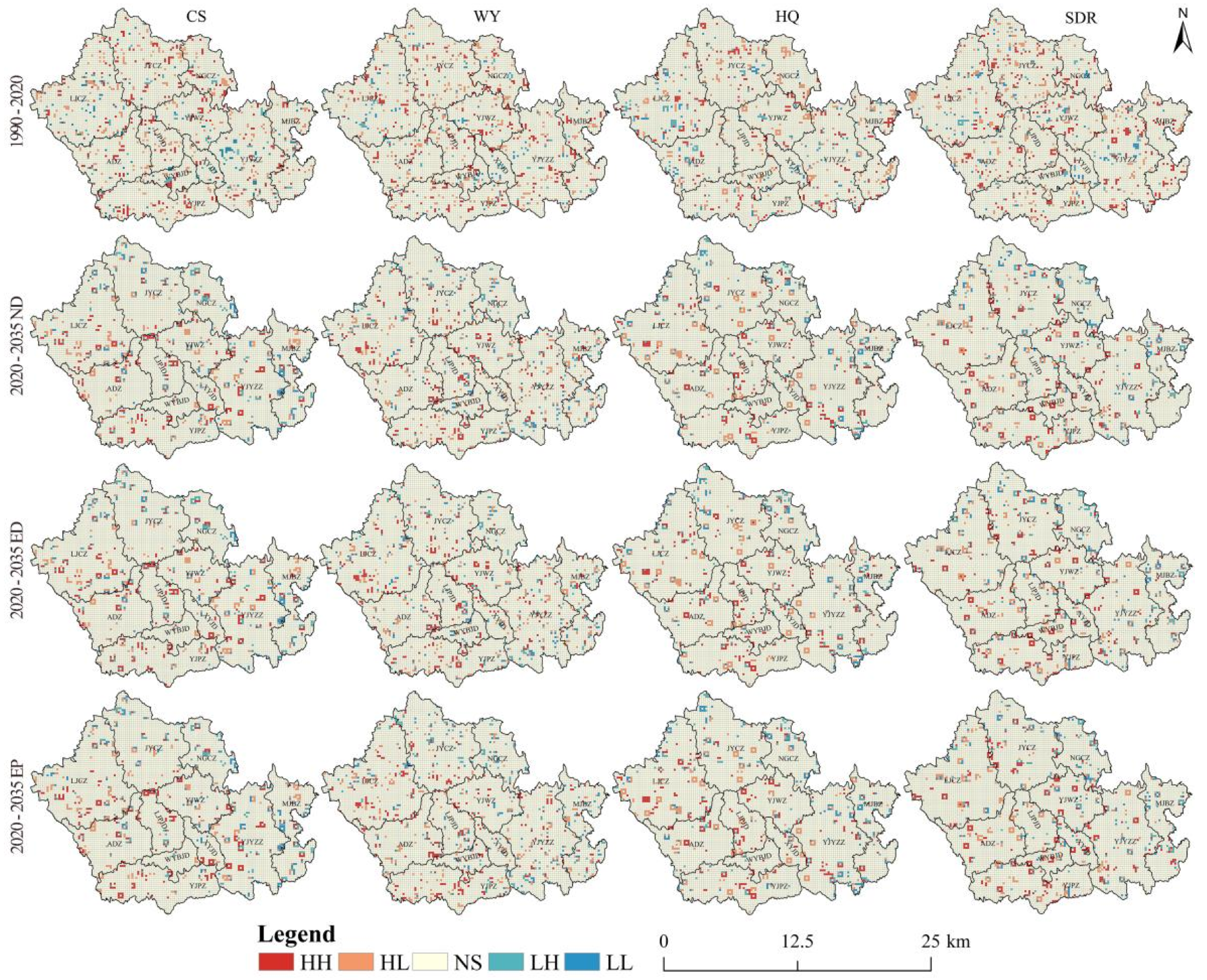
| Category | Data Type | Source | Resolution |
|---|---|---|---|
| Land use and cover | Remote sensing image | Resource Science Data Center, Chinese Academy of Sciences [24] | 30 m |
| Terrain data | DEM | ASTER Global Digital Elevation Model (ASTER GDEM) [25] | 30 m |
| Soil data | Soil attribute data | World Soil Database [26] | 1 km |
| Meteorological data | Precipitation and potential evapotranspiration | Resource Science Data Center, Chinese Academy of Sciences [24] | — |
Disclaimer/Publisher’s Note: The statements, opinions and data contained in all publications are solely those of the individual author(s) and contributor(s) and not of MDPI and/or the editor(s). MDPI and/or the editor(s) disclaim responsibility for any injury to people or property resulting from any ideas, methods, instructions or products referred to in the content. |
© 2024 by the authors. Licensee MDPI, Basel, Switzerland. This article is an open access article distributed under the terms and conditions of the Creative Commons Attribution (CC BY) license (https://creativecommons.org/licenses/by/4.0/).
Share and Cite
Zhang, Z.; Pan, H.; Liu, Y.; Sheng, S. Ecosystem Services’ Response to Land Use Intensity: A Case Study of the Hilly and Gully Region in China’s Loess Plateau. Land 2024, 13, 2039. https://doi.org/10.3390/land13122039
Zhang Z, Pan H, Liu Y, Sheng S. Ecosystem Services’ Response to Land Use Intensity: A Case Study of the Hilly and Gully Region in China’s Loess Plateau. Land. 2024; 13(12):2039. https://doi.org/10.3390/land13122039
Chicago/Turabian StyleZhang, Zhongqian, Huanli Pan, Yaqun Liu, and Shuangqing Sheng. 2024. "Ecosystem Services’ Response to Land Use Intensity: A Case Study of the Hilly and Gully Region in China’s Loess Plateau" Land 13, no. 12: 2039. https://doi.org/10.3390/land13122039
APA StyleZhang, Z., Pan, H., Liu, Y., & Sheng, S. (2024). Ecosystem Services’ Response to Land Use Intensity: A Case Study of the Hilly and Gully Region in China’s Loess Plateau. Land, 13(12), 2039. https://doi.org/10.3390/land13122039








